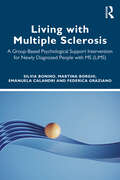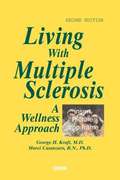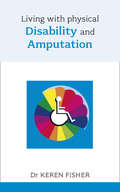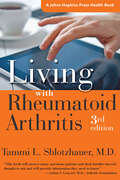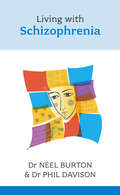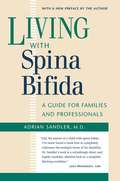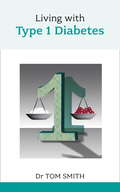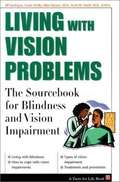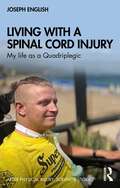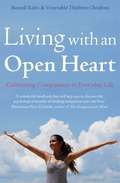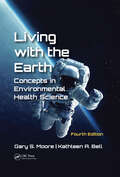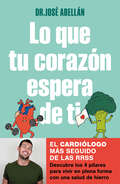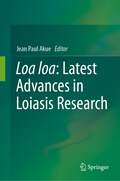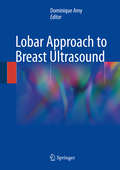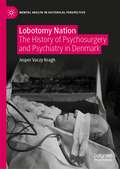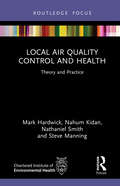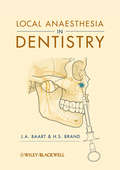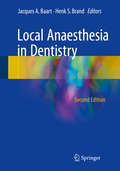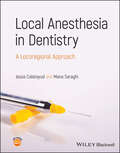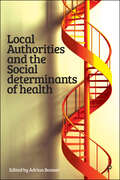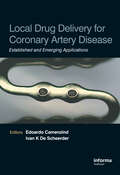- Table View
- List View
Living with Multiple Sclerosis: A Group-Based Psychological Support Intervention for Newly Diagnosed People with MS (LiMS)
by Silvia Bonino Martina Borghi Emanuela Calandri Federica GrazianoConnecting theory, research and intervention, Living with Multiple Sclerosis offers an effective, innovative and comprehensive group-based psychological support intervention specifically aimed at people newly diagnosed with Multiple Sclerosis (LiMS).The book explains the theoretical foundations of the intervention, based on developmental psychology in the life cycle, and considering the illness as a challenge to personal development. It analyzes the psychological aspects addressed in the intervention: the redefinition of identity, the sense of coherence, the sense of self-efficacy in coping with the illness, the emotional experiences, the relationship between thoughts and emotions and the effective communication strategies. Describing all session-by-session activities that are carried out in group meetings, it allows for timely replication of the intervention, whilst still accommodating possible adaptations to specific local and cultural contexts. It gives a concrete, positive perspective of personal fulfilment for people living with MS. Furthermore, it illustrates the central role of research in the project and presents new perspectives in research and intervention focused on parenthood.The book is valuable reading for psychologists, researchers and health professionals such as occupational or rehabilitation therapists working with people with MS, as well as students specializing in clinical, health or developmental psychology.
Living with Multiple Sclerosis: A Wellness Approach
by Marci Catanzaro George H. KraftThis brand-new second edition incorporates many of the most recent developments in MS management and adds new material that reflects the explosion of new management strategies for MS and its new status as a treatable disease, and new concepts of "wellness" that are of general application as well as useful in managing chronic disease. With a broad base of topics, this guide systematically shows you how to live optimally with this neurologic disease. It offers advice on how to take control of your life in order to maximize your health. The book not only addresses the diverse choices for wellness, but also pinpoints the ramifications of various behaviors and activities. You'll find answers to the most commonly asked questions about living with multiple sclerosis, including causes and course symptom management wellness management emotional health disease treatments alternative therapies and social aspects. The authors suggest some avenues for optimizing your health through exercise, nutrition, and stress management. This excellent resource provides all of the guidelines you need to start developing your own individualized wellness program.
Living with Physical Disability and Amputation
by Keren FisherAccording to the Department of Health, there are 8.7 million physically disabled people in the UK. Of these, some 460,000 people have spinal cord injuries and/or amputations. Acquiring a disability brings specific problems, not just in terms of confidence, self-esteem, and adapting to a new physical reality, but of the recognized medical phenomenon of limb disconnection, which involves a mismatch between the brain's actual representation of the body shape and its physical appearance. There is plenty of mythology around 'phantom limbs' and similar, but this book takes an evidence-based look at the reality, and uses cognitive behavioural therapy and other methods to deal with it.
Living with Rheumatoid Arthritis (A Johns Hopkins Press Health Book)
by Tammi L. ShlotzhauerThe trusted guide that has helped thousands of people cope with this painful condition—now thoroughly updated and revised.Rheumatoid arthritis is an autoimmune disease in which inflammation plays a major role in causing joint problems. Warmth and swelling in the joints, along with significant stiffness and pain, can make daily life difficult. Many people with rheumatoid arthritis also experience fatigue, low-grade fever, loss of appetite, depression, and muscle aches.In this, the third edition of Living with Rheumatoid Arthritis, Tammi L. Shlotzhauer describes new findings about causes and treatments, including • New research on risk factors and triggers, including pathologic bacteria in the digestive tract, smoking, and exposure to pollutants and chemicals• Lifestyle and diet modifications that can help avoid potential triggers • How stress contributes to inflammation and other symptoms • Information about new biologic disease-modifying drugs • Promising research on biomarkers that may generate a personalized approach to treatment • Remarkable gains in reducing disability, hospitalizations, and surgeriesIn addition to explaining the causes, symptoms, and treatment options for people who have rheumatoid arthritis, Dr. Shlotzhauer offers practical strategies for coping with the pain, fatigue, and emotional toll of a chronic illness. She provides new information on associated diseases such as osteoporosis, tips for finding safe and reliable information online, and information on how to get an accurate diagnosis.
Living with Schizophrenia
by Neel BurtonThere is a perception that schizophrenia is both uncommon and impossible to treat. In fact, it affects about 650,000 people in the UK, 2.2 million in the US, and some 50 million globally; and, the treatment success rate with today's medication and therapy can be high.It affects men and women in equal proportions, but often appears earlier in men. Symptoms are often terrifying and include visual and auditory hallucinations and acute paranoia, which may leave sufferers withdrawn, and incomprehensible or frightening to others.Living with Schizophrenia aims to fill a gaping hole in the market for information and self-help guides by addressing the needs of people with schizophrenia and their carers, relatives, and friends. Topics include:Authoritative description of what schizophrenia is and isn'tInformation and support for families and friends; how they can helpDiagnosisPhysical treatmentsPsychological treatments (talking therapies)Social interventionsFurther help
Living with Spina Bifida
by Adrian SandlerIt is the most common complex birth defect. Spina bifida affects approximately one out of every 1,000 children born in the United States. In this comprehensive guide, Dr. Adrian Sandler offers a wealth of useful information on the medical, developmental, and psychological aspects of this condition. Accurate, accessible, and up-to-date, Living with Spina Bifida is written especially for families and professionals who care for children, adolescents, and adults with spina bifida. This edition contains a new preface by the author, addressing recent developments in research and treatment, as well as an updated list of spina bifida associations.
Living with Type 1 Diabetes
by Tom SmithDiabetes is on the increase in all age groups and is described by the World Health Organisation as an epidemic. The good news is that effective control can greatly improve life expectancy, as well as reducing the risk of complications such as cardiovascular disease, stroke, kidney disease and blindness. This book explains how to tackle type one diabetes in adults and teenagers; it also looks at type two diabetes and explains why the dividing line between types one and two is not always easy to draw. Topics include: Late-onset type one diabetes; Organising your insulin; Pumps and transplants; Type two diabetes and the metabolic syndrome; Why so many more people with type two diabetes now need insulin for control; Managing type two diabetes - keeping the glucose levels down; Diet and weight control; Why you mustn't smoke - and how to stop if you do.
Living with Type 1 Diabetes
by Tom SmithDiabetes is on the increase in all age groups and is described by the World Health Organisation as an epidemic. The good news is that effective control can greatly improve life expectancy, as well as reducing the risk of complications such as cardiovascular disease, stroke, kidney disease and blindness. This book explains how to tackle type one diabetes in adults and teenagers; it also looks at type two diabetes and explains why the dividing line between types one and two is not always easy to draw. Topics include: Late-onset type one diabetes; Organising your insulin; Pumps and transplants; Type two diabetes and the metabolic syndrome; Why so many more people with type two diabetes now need insulin for control; Managing type two diabetes - keeping the glucose levels down; Diet and weight control; Why you mustn't smoke - and how to stop if you do.
Living with Vision Problems: The Sourcebook for Blindness and Vision Impairment
by Jill Sardegna Susan Shelly Allan Rutzen Scott M. SteidlMillions of Americans have a significant level of vision impairment. This revised edition of Living with Vision Problems is designed to provide students with helpful information such as: how to cope, causes and types of vision impairments, preventions, treatments and even LASIK procedures. It is an extensive sourcebook for all topics, including medical, concerning blindness.
Living with Water
by Paul Pechan Gert E. de VriesThe factors affecting water quality are many: The increasing buying power and health concerns of the world population contribute to the creation of new products whose production and disposal lead to the release of chemicals harmful to the environment; the ever-growing world population requires a steady food supply, which increases the pressure to use even more chemicals to control various crop pests; and due to climate change, head waters, rivers, and oceans are becoming increasingly warmer, acidic, and eutrophic as the result of carbod dioxide overload. Using specific examples, Water Quality and Resource Management will address the many challenges of providing clean water to the growing world population. It will also discuss the new technologies that are being developed, for example, to treat and reuse waste waters, and the innovative monitoring approaches that help scientists to assess water quality risks. Such risk assessments are urgently needed to help draft legislations and allow enforcement to ensure accessability to quality water for all. The structure of the book will be the following: Each chapter will provide information about a specific water environment and the challenges it faces. This will be followed by discussion of the pollution effects and actions taken to redress the situation. Finally, future trends will be discussed.
Living with a Black Dog
by Matthew Johnstone Ainsley JohnstoneAs beautifully illustrated as it is touching, this second book from Matthew Johnstone, author of I Had a Black Dog, is written for those who care for those suffering from depression - friends, family members, colleagues, and even therapists. Using wonderful illustrations and the image of Churchill's infamous 'black dog', Matthew and his wife Ainsley offer a moving, inspirational and often humorous portrait of life with depression - not only for those suffering from it themselves, but for those close to them. Living with a Black Dog speaks directly to the carer and offers practical and sometimes tongue-in-cheek tips on helping the depression sufferer, such as 'Socks have little do with mental health. If people could just "snap out of it" they would.' and 'Encourage any form of regular exercise. Fitness robs the Dog of its power'. Based on their own experiences, Matthew and his wife Ainsley treat the subject of depression sympathetically, hopefully and, most importantly, humorously.
Living with a Spinal Cord Injury: My life as a Quadriplegic
by Joseph EnglishJoseph English was living his best life when a car accident changed everything. He suffered life changing injuries, and the doctors told him there was no chance of recovery. Facing life as a quadriplegic, Joe lost his business, his romantic partner, and, for a while, his will to carry on. His story, told with extensive contributions from his family and friends, charts his journey from being dead at the roadside to finding something to live for as he recounts his progress from injury to survival. With absolute candour, Joe tells the whole story of his accident, his rehabilitation, and his recovery. Full of advice and suggestions from professionals in the rehabilitation journey, this book is remarkably frank about the struggles Joe has endured, and the times when he felt as if life wasn’t worth living. It addresses all the most difficult issues around life after paralysis, including loss of identity and letting go of the past, as well as providing practical information on topics such as assistive technology, financial claims and legal support. It also outlines the various roles of those in the rehabilitation team. His doctors and specialist practitioners give their unique perspectives into their processes and procedures, helping to demystify them, while Joe’s family and friends ask the kinds of questions readers will be asking too, making this an invaluable guide to what to expect for anyone going through a similar experience. The book shows – by lived example – that there is always more to live for. It is essential reading for those with paraplegia, quadriplegia and other spinal injuries, and their families, friends and care-givers. It is also valuable for neuropsychologists, neurologists and other rehabilitation therapists, as well as students in medicine, nursing, allied health and neuropsychology.
Living with an Open Heart: How to Cultivate Compassion in Everyday Life
by Thubten Chodron Russell KoltsLiving with an Open Heart contains brief readings which blend Buddhist and western psychology. It thoughtfully presents ideas and techniques drawn from Buddhism, western psychological approaches, as well as the authors' personal experiences in working to develop compassion in their own lives and in their work with others. Designed to be easy to dip into, this fascinating book is organised into brief chapters to include discussions, reflections and contemplations, personal stories, and specific techniques for deepening compassion. Each chapter provides fuel for thought and contemplation as the reader goes through his or her day, inspiring their motivation to be compassionate, helping them to understand compassion, and giving them specific methods for applying it in their lives.
Living with the Earth, Fourth Edition: Concepts in Environmental Health Science
by Gary S. Moore Kathleen A. BellShelving Guide; Environmental ScienceThis is a groundbreaking and innovative book now in its fourth edition. The first edition won the CHOICE award for outstanding Academic Book while editions two and three became bestsellers on their own right. This fourth edition is packed with new updates on current world events associated with environmental issues and related health concerns. The author maintains traditional concepts and merges them with new and controversial issues. The book has been revised to include up-to-date topics with and a revised Web site with updated links.So what Coverage of emergency preparedness for environmental health practitioners Discussion of population dynamics especially with regard to overpopulation and underpopulation around the world and their respective influences on social, economic, and environmental concerns. The mechanisms of environmental disease, emphasizing genetic disease and its role in developmental disorders and cancer. Human behaviors and pollution are presented along with respect to their roles in cancer risk. The ever increasing issues surrounding emerging and re-emerging diseases around the earth and the introduction of an increasing number of emerging diseases. The growing problems of asthma and other health effects associated with air pollution. An exploration of the mechanisms of toxicity with special reference to the immune system and endocrine disruption. The ongoing issues of the creation and disposal of hazardous waste along with the controversies surrounding disposal are presented. The issues and benefits of recycling are explored. The use of HACCP in assuring food quality, food safety issues, and the Food Quality Protection Act are discussed. Numerous technical illustrations, charts, graphs, and photographs are included What on the Web? Test bank and study questions giving a complete review of the concepts covered. Search tools for online journals and databases covering useful, up-to-date information in health and environmental topics Subject specific links by chapter as well as Federal, state, and organization sites with relevant information Downloadable PowerPoint files for each Chapter providing the instructor with ready-made presentation materials that can be modified as needed. Downloadable and printable test questions and answers for each chapter available to instructors
Llibre de la Marato 2020: Aquesta Marató toca a tothom
by Varios autoresEl llibre de La Marató d'enguany, esta dedicat a recudar fons pel a la recerca de la Covid-19. Sobren les paraules, o no les sabem trobar. S'han amagat darrere les nostres mirades i els nostres sentiments. La Covid-19 se'ns ha ficat entre els plecs del dia a dia a tots, i tots hem sigut actors i espectadors d'una situació que no podíem imaginar ni en el pitjor dels malsons. La majoria hem restat a casa, con nats molt temps. Però n'hi ha que han plantat cara al virus, que l'han buscat pels racons i l'han perpetuat en una imatge. Són els fotògrafs i els fotoperiodistes: ells han entomat el repte de mirar als ulls els qui han patit, els qui hem patit aquesta ofensa a la nostra salut, a la nostra convivència, a molts dels nostres somnis. Anna Surinyach, Cristina García Rodero, Donna Ferrato, Chema Madoz, Emilio Morenatti, Gervasio Sánchez, Isabel Muñoz Vilallonga, Jordi Borràs Abelló, Lua Ribeira, Noemí Elias, Ofelia de Pablo i Javier Zurita, Oriol Alamany Sesé, Ricard García-Vilanova, Samuel Aranda, Susana Vera, Tomeu Coll i Xavier Bertral omplen aquest llibre de tot allò que no poden expressar les paraules: l'omplen de la cruesa, la tendresa i la solidaritat que envolta aquesta inesperada situació, quereclama de tots nosaltres un cop de mà (o de colze), perquè ens necessitem, els uns als altres, més que mai. No els calen paraules, tot i que els les hem demanat. Com també els les hem demanat a dos experts que han treballat per guarir els nostres cossos i les nostres ments: el doctor epidemiòleg Antoni Trilla i la doctora en psicología Jenny Moix ens expliquen la seva feina i la seva vida durant la pandèmia. La Marató, aquest any més que mai, és al costat de tots, i, potser més que mai, tots haurem d'estar al costat de La Marató.
Lo que tu corazón espera de ti: Descubre los 4 pilares para vivir en plena forma con una salud de hierro
by Dr. José AbellánUn enfoque integrativo de la salud, con el corazón en el centro, para prevenir las enfermedades y mejorar nuestra calidad de vida. El principal motivo por el que enfermamos en la actualidad es que nuestro estilo de vida contradice lo que el cuerpo y el corazón esperan de nosotros: pasamos largas horas sentados, comemos alimentos procesados, sufrimos estrés, ansiedad, insomnio..., vivimos desconectados de nuestra naturaleza y de nuestro entorno. Esta es la raíz de muchas enfermedades, en especial las cardiovasculares, que, según la OMS, están detrás de una de cada tres muertes en el mundo y representan la mayor amenaza para nuestra salud. Y los números no paran de empeorar. En este libro, el cardiólogo José Abellán explica de manera clara y directa la importancia de cuidar la salud de nuestro corazón para evitar enfermedades y tener una vida sana, larga y activa. Con un enfoque centrado en la prevención y la incorporación de hábitos saludables, el autor profundiza en los cuatro pilares de la salud cardiovascular: * No comas, aliméntate* Muévete* Sincronízate con los ritmos del planeta y descansa* Conecta con los demás y con la naturaleza Con Lo que tu corazón espera de ti entenderás, por fin, qué necesita tu cuerpo para estar sano y aprenderás a adecuar tu estilo de vida para gozar de una salud óptima.Toma el control de la situación. Si aprendes a prevenir, no tendrán que curarte. Los expertos opinan:«José ha escrito un libro maravilloso. Lo que tu corazón espera de ti encierra mucho: por qué se produce la enfermedad y, a partir de ahí, cómo debemos alimentarnos, cómo debemos entrenar, cómo debemos sincronizarnos con el planeta y cómo debemos cuidarnos a nosotros y cuidar a los demás. Sácale jugo, aprende y disfrútalo». JORDI CRUZ, chef seis estrellas Michelin «El doctor Abellán defiende la alimentación y su poder antiinflamatorio como base para la prevención de enfermedades; en su libro desmiente de forma sencilla los principales mitos de la alimentación y su efecto en la salud cardiovascular».BLANCA GARCÍA-OREA, nutricionista, autora de Dime qué comes y te diré qué bacterias tienes «El doctor Abellán consigue transmitir los fundamentos que explican por qué el ejercicio físico y la alimentación son vitales para la salud de tu corazón. Además, explica otros factores relevantes en la salud cardiovascular, como, por ejemplo, la conexión social o el estrés. Un libro asequible y claro para mejorar tu salud plena».ISMAEL GALANCHO, nutricionista, autor de Quema tu dieta«En este libro, el doctor Abellán transmite, con un lenguaje muy sencillo y directo, lo importante que es para el corazón sincronizar tus relojes internos con los ciclos del planeta. Con su lectura aprenderás que la salud se trabaja y se gana día a día, y entenderás por qué descansar adecuadamente es uno de los pilares de una vida sana».JUAN ANTONIO MADRID, investigador experto en cronobiología, autor de Cronobiología. Una guía para descubrir tu reloj biológico «En esta época de confrontación, el doctor Abellán muestra de manera muy clara la importancia de cuidarnos, mimar nuestras relaciones con los demás y huir del estrés crónico para gozar de buena salud. Lo que tu corazón espera de ti es, en cierto modo, una delicada manera de tomar consciencia».Coronel PEDRO BAÑOS, especialista en geoestrategia y defensa, autor de Así se domina el mundo
Loa loa: Latest Advances in Loiasis Research
by Jean Paul AkueThis comprehensive volume covers all aspects from the historical discovery of the filarial parasite Loa loa to the latest diagnostics and therapies for all forms of pathology used at the point of care. Current developments in these areas are also highlighted. Expert authors present the epidemiological impact of loiasis and the basic mechanisms underlying the disease in native populations and nonresidents of endemic areas. In addition to particulars on the immunology of the parasite, its general and molecular biology, the clinical manifestation is also described in detail. Both common and atypical clinical manifestations are considered. This book concludes with an outlook on further research and targeted eradication of the disease.Loa loa, known as the "eye worm", is endemic in the rural populations of several African countries and is transmitted by rainforest deerflies. It displays impressive immune adaptation with a wide range of clinical symptoms that remain largely unexplored. The characteristics of this nematode make it of great interest to physicians and researchers specializing in infectious diseases, epidemiology, and immunology. In addition, students and family physicians working with African immigrants and travelers should know about this parasite.Loiasis is a prime example of a neglected disease under the conditions of international health efforts in our globalized world. The present work is intended to promote progress in this field, making it a valuable read within the scope of the UN Sustainable Development Goal 3 (Good Health and Well-Being).
Lobar Approach to Breast Ultrasound
by Dominique AmyThis book focuses on the lobar anatomy of the breast and on the sick lobe concept – a novel theory of breast cancer development that is gaining ever wider acceptance – and explores their significance for innovative surgical treatment. Special attention is paid to the role of ductal echography, a technique capable of clearly depicting the structures of cancer in relation to the structures of the sick lobe. Having established a sound theoretical and practical basis through detailed coverage and correlation of anatomy, pathology, and imaging appearances, the book goes on to describe a revolutionary surgical approach particularly suitable for the treatment of multifocal and multicentric breast carcinomas. Such tumors account for more than a third of all cases of breast carcinoma and are often treated by mastectomy. The proposed new breast-conserving technique yields excellent cosmetic results and entails a very low risk of recurrence. The book will appeal to a wide readership, including radiologists, surgeons, oncologists, pathologists, as well as residents.
Lobotomy Nation: The History of Psychosurgery and Psychiatry in Denmark (Mental Health in Historical Perspective)
by Jesper Vaczy KraghThis book tells the story of one of medicine’s most (in)famous treatments: the neurosurgical operation commonly known as lobotomy. Invented by Portuguese neurologist Egas Moniz in 1935, lobotomy or psychosurgery became widely used in a number of countries, including Denmark, where the treatment had a major breakthrough. In fact, evidence suggests that more lobotomies were performed in Denmark than any other country. However, the reason behind this unofficial world record has not yet been fully understood. Lobotomy Nation traces the history of psychosurgery and its ties to other psychiatric treatments such as malaria fever therapy, Cardiazol shock and insulin coma therapy, but it also situates lobotomy within a broader context. The book argues that the rise and fall of lobotomy is not just a story about psychiatry, it is also about society, culture and interventions towards vulnerable groups in the 20th century.
Local Air Quality Control and Health: Theory and Practice (Routledge Focus on Environmental Health)
by Mark Hardwick Nahum Kidan Nathaniel Smith Steve ManningThis highly accessible book identifies the major air pollutants which cause human health concerns and examines the sources of these pollutants. With a focus on NOx gases, particulate matter (PM), tropospheric ozone, and volatile organic compounds (VOCs), Part 1 covers the theory and relates these pollutants to specific health outcomes by examining the nature of anatomical/physiological systems which are affected and the mechanisms by which these effects take place.Part 2 explores the legal and policy frameworks that govern local air quality management in the UK. It examines the responsibilities and powers of regulators, the role of national and international legislation, and how law and guidance are used to protect public health and improve environmental outcomes. Part 3 outlines the role of environmental health practitioners (EHPs) in dealing with local air quality management for communities before the applications used to control pollution are discussed, both in terms of using the law effectively and technological interventions which can trap air pollution at source.The book is principally aimed at undergraduate and/or post graduate students in Environmental Health and Public Health and EHPs practising in the field of air quality control. It will also be relevant to students of environmental sciences, health sciences, medicine and environmental law and policy.
Local Anaesthesia in Dentistry
by J. A. Baart H. S. BrandLocal Anaesthesia in Dentistry is a practical guide for both students and general practitioners to this essential area of clinical practice. Highly illustrated in full colour throughout, the book provides clear and practical guidance to the administration of local anaesthesia. The book introduces the reader to the concept of nerve conduction and pain as well as providing an explanation of the anatomy of the trigeminal nerve. Further chapters cover such key areas of practice as regional anaesthesia, local anaesthesia in children, pharmacology, local and systemic complications, general practical aspects, the prevention of side effects and legal aspects.
Local Anaesthesia in Dentistry
by Jacques A. Baart Henk S. BrandThis book, richly illustrated in full colour, is a comprehensive guide to the use of local anesthesia in dentistry that will meet the needs of both students and dental practitioners. It provides the reader with ample background information on the origin of pain and the pharmacology of anesthetics, and describes the anatomy of the trigeminal nerve in detail. Subsequent chapters cover key are as such as general practical aspects, local anesthesia in the upper and the lower jaw, the use of local anesthetics in children, local and systematic complications, and the prevention of side effects. Patients at particular risk of adverse effects are identified and attention drawn to significant legal aspects. This second edition has been completely revised, with more attention to safety, environment, and sterility. Additional injection techniques have been included, and a new chapter is devoted to microprocessor-assisted administration of anesthetics. Throughout, care has been taken to ensure that the information is clearly presented and the text is easy to read.
Local Anesthesia in Dentistry: A Locoregional Approach
by Jesús Calatayud Mana SaraghiLocal Anesthesia in Dentistry Distills the current body of knowledge in local anesthesia into a single, easy-to-use volume Local Anesthesia in Dentistry: A Locoregional Approach provides comprehensive coverage of all aspects of local anesthetics, including anatomic considerations, pharmacology, armamentarium, injection techniques, indications, contraindications, complications, novel anesthetics formulations, and more. In-depth chapters offer clear criteria and guidelines for patient care, supported by hundreds of evidence-based references. Alongside this, standalone appendixes are hosted on the book’s companion website. In these appendixes, the authors have distilled a wide body of research, summarizing the findings of the seminal studies in the field, including historical landmark studies and clinical trial data to support practical aspects of locoregional anesthesia discussed in the textbook. This easy-to-use volume: Provides students and professionals with a one-stop resource on local anesthesia in dentistry Offers critical evaluations of research and literature on each topic and subtopic Addresses all common local anesthetic techniques, including basic injection, mandibular and maxillary anesthesia, and local anesthesia in children Features practical quantitative data and step-by-step information on situations encountered in daily practice Designed to support all levels of dental professionals, Local Anesthesia in Dentistry: A Locoregional Approach is written by two highly experienced practitioners, making this authoritative resource a must-have for dentists, dental nurses, dental technicians, hygienists, specialists, students, and researchers. It is also a valuable reference for other healthcare providers looking to support future study.
Local Authorities and the Social Determinants of Health
by Adrian BonnerAs many social inequalities widen, this is a crucial survey of local authorities’ evolving role in health, social care and wellbeing. Health and social and public policy experts review structural changes in provision and procurement, and explore social determinants of health including intergenerational needs and housing. With detailed assessments of regional disparities and case studies of effective strategies and interventions from local authorities, this collaborative study addresses complex issues (Wicked Issues), considers where responsibility for wellbeing lies and points the way to future policy-making. The Centre for Partnering (CfP) is a key outcome of this innovative review along with Bonner’s previous work Social Determinants of Health (2017).
Local Drug Delivery for Coronary Artery Disease: Established and Emerging Applications
by Edoardo Camenzind Ivan K De ScheerderPioneers in the field, the editors have assembled an excellent team of contributors with extensive experience of threatened vessel closure and restenosis, acute thrombosis, hyperproliferative cellular response, stents and local drug delivery. Comprehensive and up-to-date, this reference provides fully up-to-date information on currently available methods of drug delivery, as well as illustrations of drug delivery methods with seventy-five color and seventy-five black and white photos throughout the book. With this impressive presentation of the most up-to-date methods and applications, as well as a range of photographs illustrating their implementation, this guide is an excellent resource for cardiologists, pharmacologists, cardiac surgeons, and trainees.
